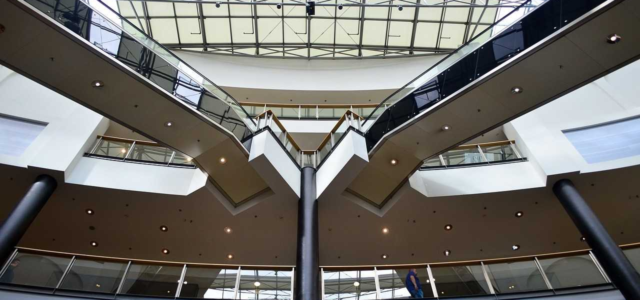Simon Bishop and Justin Waring
 This section of Discover Society is provided in collaboration with the journal, Policy and Politics. It is curated by Sarah Brown.
This section of Discover Society is provided in collaboration with the journal, Policy and Politics. It is curated by Sarah Brown.
Cutting ribbons on gleaming new buildings, politicians have long sought to bolster their public image through association with new facilities developed as the flagships of public service reform. ‘Out with the old and in with the new’ is the clearly intended message. But beyond the rhetoric of ‘cutting edge design’ and ‘state of the art working’, there are very rarely any deeper conversations of how new buildings affect the lives of the employees and public who use them daily. Even during more detailed deliberations over new facilities by planners and service managers, the focus tends to be on how new spaces are going to work functionally – cost, technical and ergonomic features of building projects are the predominant concerns.
In our Policy & Politics article, we look at the new spaces created by public service reform, not in terms of their functional efficiency, but through the way they are understood, used and, in some ways (re)made, by the various groups who spend time in them. Importantly for our work, recent public service facilities have often sought to bring together previously separate groups under one roof, as part of intended changes to service delivery. With emphasis on ‘networked’ and ‘joined up’ services, this includes bringing groups from the private, public and charitable sector together to engage in new forms of work. This could be seen as part of a wider fashion for ‘hybrid’ productive spaces, such as the ‘home-office’, ‘cafe-office’ or ‘online classroom’. Each of these is seen as changing how people work, learn, socialise and consume. But, we ask, how do people combine the different expectations, values and ways of acting implied by previous distinctions when using such hybrid spaces?
To start to answer this, our research looks at the development of new hybrid spaces in healthcare. The issue of built space in healthcare does of course bring its own set of questions. Hospital designs and locations have always been in some ways tied up with the healing properties that are invested in them and the physical layout of hospitals and the development of medical technologies and treatments have historically gone hand in hand. The adoption of pavilion hospital buildings and ‘nightingale’ wards is often associated with the start of modern approaches to hygiene and infection control. Today, new buildings and facilities are often at the heart of policies in healthcare, with the implication that changing the spaces of care provision will bring about improved service responsiveness and efficiency. For example, the primary care centres, hyper-acute units and hub and spoke models that are promoted by current health policy in the UK are all based on ideas of changing the way we use geographical and architectural space.
Our ethnographic investigation focuses on a new Independent Sector Treatment Centre (ISTC), which was funded, designed, built and operated as a public-private partnership between the NHS and private companies. At the level of policy rhetoric, ISTCs were intended by policy to make (comparatively) straightforward healthcare treatments more efficient by re-organising service delivery based on private-sector manufacturing principles, provided under the NHS umbrella. As with many such policies, the realisation of ISTCs varied wildly; some ISTCs involved major new buildings, and some were existing NHS departments with different funding – and corporate logos – stuck on. This was a highly controversial policy initiative, and certainly led in some instances to a pretty shocking waste of public resources.
To explore what staff and service users made of the spaces created by the ISTC programme in more detail, we made use of Michael Foucault’s (1986) concept of heterotopia. Foucault broadly used the term to describe spaces in which different cultural expectations are brought together, and where accepted ways of doing things can be questioned and possibly upended. Although Foucault is seen by some as someone pre-occupied with the way our lives are determined by existing powerful forces, the concept of heterotopia does appear to offer a way of seeing how certain spaces can lead to a reconsideration of existing power relations, resulting in instability and disorder. In our case, we draw on the idea of heterotopia to consider how people sought to adapt their understanding and use of the spaces of the ISTC, to take account of the potentially conflicting commercial and public healthcare ideals.
Our findings outline some of the ways that people went about working and receiving treatment within healthcare spaces that were in some parts similar to existing public hospitals, and in other parts looked more like places of consumption (like hotels and airports). In interviews with some of the managers who had been involved in designing the centre, it was clear that both economic and health service issues had played on their mind when making decisions. Several senior people spoke about how they had looked at manufacturing practices of layout, as well as taking inspiration from some of the consumer spaces they personally used. The way airports were build to improve the flow of passengers was mentioned more than once – not only as a way to speed up movement, but also as a way to improve ‘user experience’.
It was, though, difficult for managers to completely redesign the areas where healthcare treatments were actually taking place. There was certainly a difference in the feel of the ISTC between the public foyers and restaurant areas where symbols of clinical intervention were pushed to the margins, and the operating and recovery areas, which were dominated by medical equipment and information.
These different influences in design were certainly noted by staff and patients. Nurses, doctors and therapists working in the centre were largely impressed with the size and quality of the facilities which in some cases (although not always) helped them to conduct clinical tasks, but at the same time were clearly worried about what the symbols of consumption meant for the continued provision of public healthcare, and also about how a new group of managers appeared to be controlling the space. There were also staff who felt that the new design left less space for chatting with colleagues and discussing aspects of their work, with implications for patient care.
A similar message came from the patients using the centre. Again, patients often commented on the airiness and space of the public areas, while also finding some aspects of layout confusing and unexpected. Although the centre was designed as a ‘one stop shop’, many of the patients and their family members had been navigating the ‘old’ hospital for years and so were very familiar with its layout, finding the new centre rather confusing. From what patients told us, and what they said to each other, this didn’t feel like simply a case of needing to learn their way around. Patients felt the new ISTC had different implications that led them to think about their place within the new facilities and question whether they could have the same expectations of care.
From our examples, we suggest that such spaces did appear to open up some possibility of human agency, because they took away – or at least gave people cause to reconsider – taken for granted ways of using the healthcare space. The commercial and consumer aspects of new healthcare facilities, alongside traditional markers of public healthcare, meant that people had to make choices about how they should act and what forms of interaction were appropriate. Taking this further, we discuss how such heterotopias might be seen as spaces in which social relations can be inverted or disrupted, not only because of the presence of incongruous elements within the physical space, but also because of the effort and agency involved in trying to accommodate and possibly reconcile the differing demands that different elements made on people.
While it is clearly the financial imperative that lies behind many cross-sector partnerships, new spaces created by them have implications for our lives and sensibilities beyond value for public money. Given the direction of public policy travel, we think that further consideration of how hybrid spaces are coming to dominate the public service landscape is now needed.
Reference:
Foucault, Michel (1986), ‘Of Other Spaces’. Diacritics No. 16, 22-27.
Simon Bishop is Associate Professor in Organisational Behaviour and Director of the Executive MBA Healthcare at Nottingham University Business School. Justin Waring is Professor in Organisational Behaviour and Human Resource Management at Nottingham University Business School.
